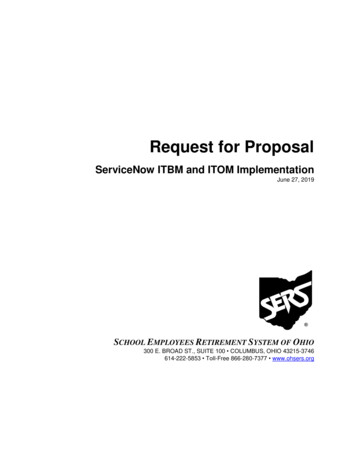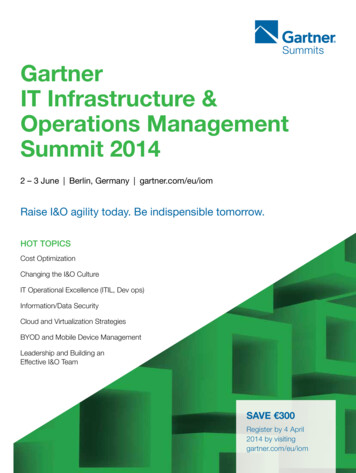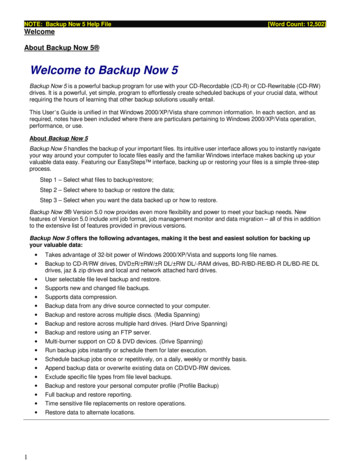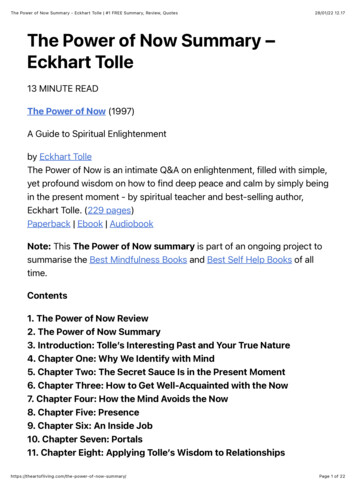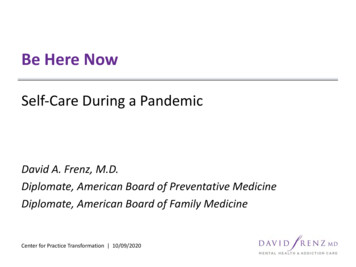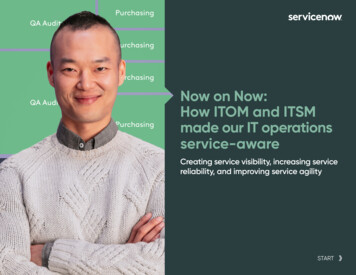
Transcription
Now on Now:How ITOM and ITSMmade our IT operationsservice-awareCreating service visibility, increasing servicereliability, and improving service agilitySTART1
IntroductionServiceNow is committed to creating great experiences for ourcustomers and employees. It’s why digitalization is so important forus. In every area of our company, we’re using digital technology totransform the way we work, how we interact with our customers,and how we run our business.To fulfill this promise, we need high-performance, high-availabilitybusiness services. Our enterprise applications and digitalinfrastructure must be rock-solid. Service outages and bottlenecksaren’t acceptable. They cost too much, damage our business, and–most importantly–they let down our customers. And to acceleratedigitalization, we also need an incredibly agile IT environment–onewhere automation turns days into minutes.IT operations is the engine that drives service reliability and agility.By leveraging the combined power of ServiceNow IT OperationsManagement and ServiceNow IT Service Management, we’ve putour own IT operations engine into high gear–and we continue tomove faster and faster.In this eBook, we look at the challenges we faced, how weaddressed them, and the benefits we’ve realized. We hope ourstory helps guide you on your journey into the digital future.2
Meet Joe Corpion and his team“We had to fundamentallychange how we operated.Instead of an infrastructureoriented NOC, we neededa Service Reliability Team(SRT) that focused on whatmatters–the businessservices our companyrelies on.”Joe Corpion runs ServiceNow global IT operations. He’s led histeam through a far-reaching transformation, dramatically increasingbusiness service quality, accelerating service delivery, and increasingoperational efficiency.Incident overload, slow response,and lack of service visibilityWhen Joe began this journey, he had many of the same challengesthat other IT operations teams face. He says, “We were overloadedwith P1 and P2 incidents, which put a huge strain on our resources.Because of this, we were slow to respond, which directly impactedthe business. And, we operated in infrastructure silos because wehad no end-to-end service visibility. That meant we had severalpeople chasing different symptoms of the same underlying issue,creating more work and more delays.”Too many emails and escalationsJoe CorpionServiceNow GlobalIT OperationsMichael Prouty, who oversees Joe’s global operations team, agrees.“When there was an issue, everyone’s inboxes would fill up withemails from our monitoring systems. The event noise was enormous,and juggling hundreds of emails made it worse. The voice teamthought there was a voice problem. The network team thought therewas a network problem. The systems team thought that there was aserver problem. And so on. Meanwhile, we were dealing with multipleescalations, which created chaos in our NOC. It would often take usan hour or more before we realized everything was related.”3
From NOC to SRTHow did Joe and his team drive this shift from infrastructureto services?Building the foundationFor Joe, it starts with the CMDB. He explains, “The CMDB anddiscovery are the foundation for everything. You need a consistentand reliable view of your infrastructure. Otherwise, you can’tmanage it effectively. By adopting a standardized CMDB modeland keeping it up to date with discovery, you get that visibility. Ifyour CMDB model is customized, consider going back to the outof-the-box CMDB model and fix any significant data issues, suchas duplicates or other inconsistencies.”Joe also stresses the importance of governance. “We put a lotof focus on defining processes, roles, and responsibilities aroundour CMDB. Proper governance is critical to keep your CMDBhealthy. Otherwise, your CMDB will fall into disrepair, and youreffort is wasted. Remember, your CMDB isn’t just an infrastructuredatabase. For example, it contains critical process informationsuch as CI owners, and you need to make sure that the rightstakeholders keep this up to date and accurate as well.”4
Creating service visibility across ITOM and ITSMNext, Joe’s team mapped their most important business servicesusing ServiceNow Service Mapping, making their CMDB serviceaware. Joe says, “Service maps are essential when you’re trying todiagnose and resolve service issues. And, they also tie directly intoITSM processes. For example, if you have a change request thatinvolves taking a server in Dallas offline, how do you find out whichbusiness services will be affected? Without service maps, youjust don’t know.”“We started with our most critical services. Some of these have verycomplex topologies. For example, our Cisco contact center servicehas more than 50 types of components. However, by followingbest practices and working with our professional services team,we mapped this successfully. And, once we map a service, ServiceMapping keeps the map up to date, so we don’t have to keep onrefreshing and maintaining it–unlike with Visio.”5
Managing business service healthNow that Joe’s team had a service-aware CMDB, they were readyto transform their NOC into an SRT. They used ServiceNow EventManagement to integrate, normalize, deduplicate, and correlatedata across their monitoring systems, including SolarWinds, Splunk,and SAP Solution Manager.According to Joe, “We’ve seen a 98% reduction in incident noise,even though our monitoring systems were already relatively welloptimized. And, we no longer have to deal with emails. Instead,Event Management automatically reduces all of our events intoa small number of actionable incidents, which ServiceNow IncidentManagement automatically routes to the right SRT team members.”However, the benefits go far beyond noise reduction. Because EventManagement uses service maps to correlate events, Joe’s team nowhas a real-time view of business service health. Joe says, “The EventManagement dashboard gives us a single pane of glass where wesee the health of all of our business services. Instead of struggling withsiloed infrastructure on multiple monitoring screens, we work togetheras a team to quickly resolve service issues. That’s critical. It’s poweredour shift from a NOC to a true SRT.”98%REDUCTION IN INCIDENTNOISE VIA CORRELATIONAND DEDUPLICATION6
50% MTTR reduction“When we started out, our goal was to reduce MTTR by 50%,”Joe relates. “We’ve achieved that. There are a lot of contributingfactors, including process improvements and skills development,but Event Management plays a huge role. Because we seethe status of all our business services, we can prioritize better,respond instantly, and get the right people together quickly. And,since we can drill down from top-level business health into theunderlying service maps, we can see right away which CIs arecausing the issue. That means we diagnose and resolve serviceoutages much faster.”Thangavel Viswam, who leads Joe’s infrastructure team, gives anexample. “Our Master Data Management business service handlesemployee and customer information across ServiceNow, so it’scritical,” he says. “In one case, we had a significant outage. Wesaw this on the Event Management dashboard and contactedthe MDM team right away. MDM depends on many applications,so we used our service maps to help the MDM team diagnoseand resolve the issue. That saved us two precious hours.”Thangavel ViswamSenior Manager,IT Service Reliability Team7
67% reduction in high-priority incidentsWith Event Management, we’ve also dramatically reduced thenumber of high-priority incidents. According to Joe, “When you’redealing with fewer incidents, you can focus on what’s importantand fix things faster–which is another reason why our MTTRhas come down. We’ve seen our P1 and P2 incidents in the NOCreduced by 67%, which has a huge impact.”“Part of that reduction is because we now get a single actionableincident, rather than multiple uncorrelated incidents,” Joe adds.“But, we’re also able to prevent incidents. With ITOM’s OperationalIntelligence, we use machine learning to spot anomalies, such asabnormally high numbers of CPU utilization alerts. That meanswe can investigate and fix the issue before things get worse andcause an outage.”67%REDUCTION IN P1 AND P2INCIDENTS VIA EVENTMANAGEMENT8
9,600HOURS SAVED PER YEARVIA AUTOMATED ALERTMANAGEMENTIncreasing efficiency and agilityWith ITOM, Joe and his team are saving 9,600 hours a year inthe SRT alone. However, that's just the start. They are also usingITOM to automate IT operations processes, slashing the time ittakes to get things done. In fact, work is already underway toautomate more than 20 IT operations processes using ServiceNow Orchestration, with more to come.Joe points to a process automation success–creating virtualmachines (VMs). “Creating a VM involves more than a dozentasks,” he explains. “Before, when someone needed a new VM, wewould create it manually. On average, users had to wait 40 hoursto get their VM. Now, we use ServiceNow Cloud Managementto automate the entire process. Users simply enter a self-servicerequest in the ServiceNow portal, and Cloud Management usesOrchestration to carry out all the steps. Instead of wasting 40hours, the user gets their VM in 30 minutes.”“Once the VM is successfully created, Cloud Managementautomatically closes out the change. And, if it doesn’t work, CloudManagement marks the change as failed and automatically opensan incident so we can investigate. That’s a great example of howITOM and ITSM work together.”9
Lessons learnedWhat advice does Joe have for other organizations that wantto transform their IT operations? He makes three key points: Follow best practices - Rather than going it alone, learn fromthe experience of others. Joe advises, “ServiceNow ProfessionalServices has real-world experience with many customerdeployments, and they have turned this experience intodocumented best practices–whether that’s for planning yourCMDB, optimizing discovery, or mapping services. We leveragedtheir expertise throughout our transformation, and it was acritical part of our success.” Operationalize your systems and processes - Don’t just treattransformation as a one-off project. Think about what you need forcontinued operational success. “You need to define ongoing roles,responsibilities, and governance. I’ve already talked about howthis is critical for the CMDB, but it applies across the board,” Joesays. “Also, to create agility, turn ongoing work such as mappingnew services or automating additional processes into operationalactivities, rather than treating them as projects.” B ecome service-aware - ServiceNow ITOM creates servicevisibility, but you won’t get the benefits if you continue to think ininfrastructure silos. “Transforming our NOC into an SRT didn’t takesignificant organizational changes–but it did take a major shiftin mindset. Whenever our NOC engineers saw an issue, their firstinstinct was to dive into the infrastructure. We worked with themto change that,” Joe says. “Now when they see a business serviceissue, our SRT engineers take a step back and think about thebusiness impact. That’s essential.”10
The bottom lineJoe has led his team through a remarkable transformation. Byleveraging ServiceNow ITOM and ServiceNow ITSM portfolios, he hasaligned IT operations with our business, creating service visibility anddramatically increasing service availability. The results prove thatefficiency and service quality are two sides of the same coin: 50% reduction in MTTR 67% decrease in P1 and P2 incidents 9600 hours of work eliminated in the NOC every yearThe momentum continues to build. By automating IT operationsprocesses, Joe is creating an agile IT operations environment thatresponds quickly and accurately to the needs of our business,slashing service delivery times from days to minutes. That’saccelerating our digitalization–so that we can continue to delivergreat experiences for our customers and employees.11
Now on NowHow we use our own technologyLEARN MOREAbout ServiceNowServiceNow was started in 2004 with the belief that getting simple stuff done at work can be easy, and gettingcomplex multi-step tasks completed can be painless. From the beginning, ServiceNow envisioned a world whereanyone could create powerful workflows to get enterprise work done. Today, ServiceNow is the cloud-basedplatform that simplifies the way we work. ServiceNow software automates, predicts, digitizes, and optimizes businessprocesses and tasks, across IT, customer service, security, human resources, and more, to create a better experiencefor your employees and customers while transforming your enterprise. ServiceNow is how work gets done. Copyright 2018 ServiceNow, Inc. All rights reserved. ServiceNow, the ServiceNow logo, and other ServiceNow marks are trademarks and /or registered trademarks of ServiceNow, Inc., in the United States and/or other countries. Other company andproduct names may be trademarks of the respective companies with which they are associated.BACKSN-EB-NOW-ON-NOW-ITOM-072018
manage it effectively. By adopting a standardized CMDB model and keeping it up to date with discovery, you get that visibility. If your CMDB model is customized, consider going back to the out-of-the-box CMDB model and fix any significant data issues, such as duplicates or other inconsistencies." Joe also stresses the importance of governance.
